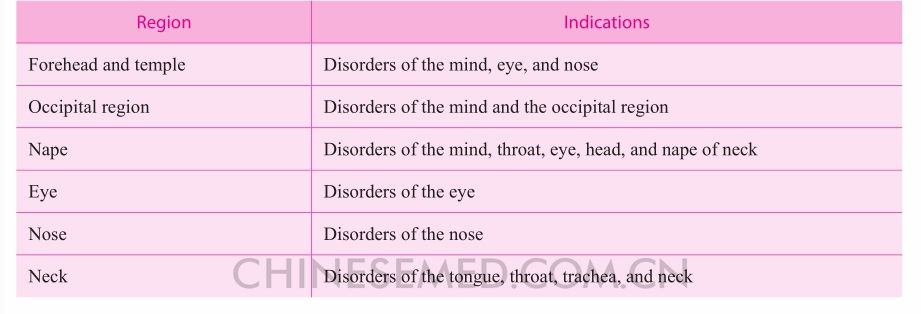Characteristics for Point Effects
Points receive stimulation, including that of acupuncture and moxibustion. They prevent and treat diseases and are the sites where qi and blood are transported and pathogenic qi invades. Using acupuncture and moxibustion to stimulate points dredges the channels, regulates the flow of qi and blood, harmonizes yin and yang with each other and with zang-fu organ functions, strengthens healthy qi, and removes pathogenic qi. The rules that govern the effects of points may be classified as follows.
1. Local Therapeutic Effects
Local therapeutic effect is a property characteristic of all points, whether channel, extra, or ashi. All points treat local and adjacent disorders. For example, RN 12 (zhōng wăn), RN 11 (jiàn lĭ), and ST 21 (liáng mén) on the upper abdomen may be used to treat gastric disorders; BL 1 (jīng míng), ST 1 (chéng qì), and ST 2 (sì bái), located around the eyes, treat ophthalmic diseases; SI 19 (tīnggōng), SJ 21 (ĕr mén), and SJ 17 (yì fēng), located around the ears, treat hearing disorders.
2. Remote Therapeutic Effects
Remote, or distal, therapeutic effects are properties of the channel points, especially those of the twelve regular channels located below the elbow or knee joints. Such points are effective not only for local disorders but also for disorders that manifest at a distance along the running courses of their pertaining channels; hence the saying, ‘the indications of points extend as far as their channels reach’. For example, LI 4 (hé gŭ) treats disorders of the upper limb but also those of the neck, head, and face; ST 36 (zú sān lĭ) treats disorders of the lower limbs and of the gastro-intestinal system and the upper part of the body.
3. Special Therapeutic Effects
In addition to local and remote therapeutic effects, some points have special effects such as bi-directional or general regulation. Many points may be used for bi-directional regulation. For instance, ST 25 (tiān shū) relieves diarrhea or constipation; PC 6 (nèi guān) decreases heart rate in patients with tachycardia but increases it in bradycardia. Some points, especially yangming channel points and those of the ren and du mai, treat general disorders: LI 4 (hé gŭ), LI 11 (qū chí), and DU 14 (dà zhuī) treat fever caused by external pathogenic qi; ST 36 (zú sān lĭ), RN 4 (guān yuán), and BL 43 (gāo huāng) tonify and preserve health. Some points have relatively specific effects on given disorders; for example, BL 67 (zhì yīn) corrects breech presentation.
Characteristics for Point Indications
Each point has a broad scope of functions directly related to its location and channel. Both its local and distal therapeutic effects are based on channel theory. There are rules or patterns in point indication that can be understood based on channel distribution and point location.
1. Characteristics of Channel Point Indications
Channel points located on the four limbs, including the five transport, yuan-source, luo-connecting, and xi-cleft points, have special therapeutic effects for disorders of the head, trunk, and zang-fu organs. These form the foundation for point indication according to channel distribution and the origin of the therapeutic rules that ancient doctors summarized and called the ‘four origins and three junctions’. Because the four limbs are considered the ‘origins’ of channels, the points on the limbs have remote therapeutic effects for disorders of the head and trunk, which are the ‘junctions’of the channels. Each channel has its own indications, and adjacent channels can have similar indications. The ‘three yin’ also have therapeutic indications in common, as do the ‘three yang’. The rules of channel indications are summarized in Tables 2-1, 2-2, 2-3, and 2-4.




2. Characteristics of Indications for the Physical Regions
The head and trunk of the body are the locations of the ‘four seas’, the ‘qi pathway’, and the ‘junctions’ and ‘branches’ of the twelve channels. The qi of zang-fu organs, abdomen, and back connect and correspond with each other. These are the rules for point indications according to physical region, and they posit a transverse relationship between channels and their own individual longitudinal courses. For example, the neck and scapular regions are located between the head and back; thus the points in this region treat local disorders, those of the throat and upper limbs, and fever. The lateral costal region corresponds to the liver and gallbladder, and the lateral abdominal region corresponds internally to the spleen and stomach. The points in these regions therefore treat disorders in the sanjiao. The region between the waist and hips corresponds to the organs in the lower jiao, and the points located in this region largely treat disorders of the lower limbs. The rules for regional point indications are listed below (Tables 2-5 and 2-6).



